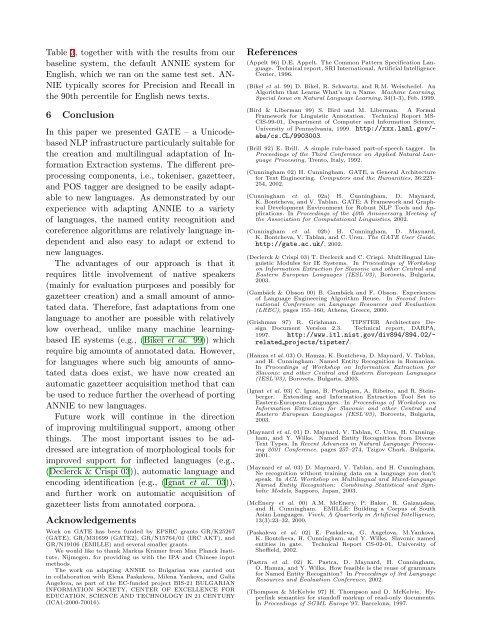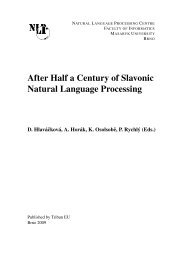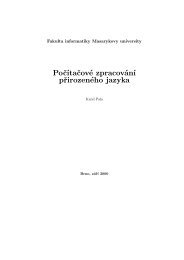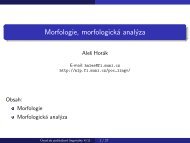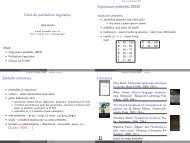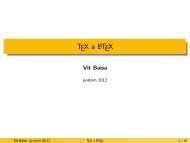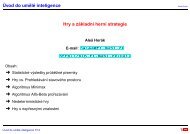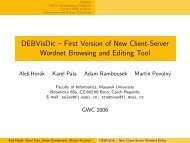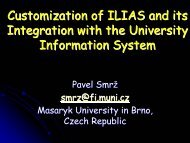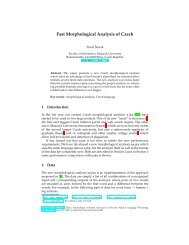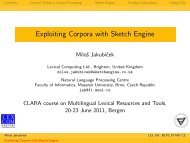GATE: A Unicode-based Infrastructure for Multilingual Information ...
GATE: A Unicode-based Infrastructure for Multilingual Information ...
GATE: A Unicode-based Infrastructure for Multilingual Information ...
Create successful ePaper yourself
Turn your PDF publications into a flip-book with our unique Google optimized e-Paper software.
Table 3, together with with the results from our<br />
baseline system, the default ANNIE system <strong>for</strong><br />
English, which we ran on the same test set. AN-<br />
NIE typically scores <strong>for</strong> Precision and Recall in<br />
the 90th percentile <strong>for</strong> English news texts.<br />
6 Conclusion<br />
In this paper we presented <strong>GATE</strong> – a <strong>Unicode</strong><strong>based</strong><br />
NLP infrastructure particularly suitable <strong>for</strong><br />
the creation and multilingual adaptation of In<strong>for</strong>mation<br />
Extraction systems. The different preprocessing<br />
components, i.e., tokeniser, gazetteer,<br />
and POS tagger are designed to be easily adaptable<br />
to new languages. As demonstrated by our<br />
experience with adapting ANNIE to a variety<br />
of languages, the named entity recognition and<br />
coreference algorithms are relatively language independent<br />
and also easy to adapt or extend to<br />
new languages.<br />
The advantages of our approach is that it<br />
requires little involvement of native speakers<br />
(mainly <strong>for</strong> evaluation purposes and possibly <strong>for</strong><br />
gazetteer creation) and a small amount of annotated<br />
data. There<strong>for</strong>e, fast adaptations from one<br />
language to another are possible with relatively<br />
low overhead, unlike many machine learning<strong>based</strong><br />
IE systems (e.g., (Bikel et al. 99)) which<br />
require big amounts of annotated data. However,<br />
<strong>for</strong> languages where such big amounts of annotated<br />
data does exist, we have now created an<br />
automatic gazetteer acquisition method that can<br />
be used to reduce further the overhead of porting<br />
ANNIE to new languages.<br />
Future work will continue in the direction<br />
of improving multilingual support, among other<br />
things. The most important issues to be addressed<br />
are integration of morphological tools <strong>for</strong><br />
improved support <strong>for</strong> inflected languages (e.g.,<br />
(Declerck & Crispi 03)), automatic language and<br />
encoding identification (e.g., (Ignat et al. 03)),<br />
and further work on automatic acquisition of<br />
gazetteer lists from annotated corpora.<br />
Acknowledgements<br />
Work on <strong>GATE</strong> has been funded by EPSRC grants GR/K25267<br />
(<strong>GATE</strong>), GR/M31699 (<strong>GATE</strong>2), GR/N15764/01 (IRC AKT), and<br />
GR/N19106 (EMILLE) and several smaller grants.<br />
We would like to thank Markus Kramer from Max Planck Institute,<br />
Nijmegen, <strong>for</strong> providing us with the IPA and Chinese input<br />
methods.<br />
The work on adapting ANNIE to Bulgarian was carried out<br />
in collaboration with Elena Paskaleva, Milena Yankova, and Galia<br />
Angelova, as part of the EC-funded project BIS-21 BULGARIAN<br />
INFORMATION SOCIETY, CENTER OF EXCELLENCE FOR<br />
EDUCATION, SCIENCE AND TECHNOLOGY IN 21 CENTURY<br />
(ICA1-2000-70016).<br />
References<br />
(Appelt 96) D.E. Appelt. The Common Pattern Specification Language.<br />
Technical report, SRI International, Artificial Intelligence<br />
Center, 1996.<br />
(Bikel et al. 99) D. Bikel, R. Schwartz, and R.M. Weischedel. An<br />
Algorithm that Learns What’s in a Name. Machine Learning,<br />
Special Issue on Natural Language Learning, 34(1-3), Feb. 1999.<br />
(Bird & Liberman 99) S. Bird and M. Liberman. A Formal<br />
Framework <strong>for</strong> Linguistic Annotation. Technical Report MS-<br />
CIS-99-01, Department of Computer and In<strong>for</strong>mation Science,<br />
University of Pennsylvania, 1999. http://xxx.lanl.gov/abs/cs.CL/9903003.<br />
(Brill 92) E. Brill. A simple rule-<strong>based</strong> part-of-speech tagger. In<br />
Proceedings of the Third Conference on Applied Natural Language<br />
Processing, Trento, Italy, 1992.<br />
(Cunningham 02) H. Cunningham. <strong>GATE</strong>, a General Architecture<br />
<strong>for</strong> Text Engineering. Computers and the Humanities, 36:223–<br />
254, 2002.<br />
(Cunningham et al. 02a) H. Cunningham, D. Maynard,<br />
K. Bontcheva, and V. Tablan. <strong>GATE</strong>: A Framework and Graphical<br />
Development Environment <strong>for</strong> Robust NLP Tools and Applications.<br />
In Proceedings of the 40th Anniversary Meeting of<br />
the Association <strong>for</strong> Computational Linguistics, 2002.<br />
(Cunningham et al. 02b) H. Cunningham, D. Maynard,<br />
K. Bontcheva, V. Tablan, and C. Ursu. The <strong>GATE</strong> User Guide.<br />
http://gate.ac.uk/, 2002.<br />
(Declerck & Crispi 03) T. Declerck and C. Crispi. <strong>Multilingual</strong> Linguistic<br />
Modules <strong>for</strong> IE Systems. In Proceedings of Workshop<br />
on In<strong>for</strong>mation Extraction <strong>for</strong> Slavonic and other Central and<br />
Eastern European Languages (IESL’03), Borovets, Bulgaria,<br />
2003.<br />
(Gambäck & Olsson 00) B. Gambäck and F. Olsson. Experiences<br />
of Language Engineering Algorithm Reuse. In Second International<br />
Conference on Language Resources and Evaluation<br />
(LREC), pages 155–160, Athens, Greece, 2000.<br />
(Grishman 97) R. Grishman. TIPSTER Architecture Design<br />
Document Version 2.3. Technical report, DARPA,<br />
1997. http://www.itl.nist.gov/div894/894.02/related<br />
projects/tipster/.<br />
(Hamza et al. 03) O. Hamza, K. Bontcheva, D. Maynard, V. Tablan,<br />
and H. Cunningham. Named Entity Recognition in Romanian.<br />
In Proceedings of Workshop on In<strong>for</strong>mation Extraction <strong>for</strong><br />
Slavonic and other Central and Eastern European Languages<br />
(IESL’03), Borovets, Bulgaria, 2003.<br />
(Ignat et al. 03) C. Ignat, B. Pouliquen, A. Ribeiro, and R. Steinberger.<br />
Extending and In<strong>for</strong>mation Extraction Tool Set to<br />
Eastern-European Languages. In Proceedings of Workshop on<br />
In<strong>for</strong>mation Extraction <strong>for</strong> Slavonic and other Central and<br />
Eastern European Languages (IESL’03), Borovets, Bulgaria,<br />
2003.<br />
(Maynard et al. 01) D. Maynard, V. Tablan, C. Ursu, H. Cunningham,<br />
and Y. Wilks. Named Entity Recognition from Diverse<br />
Text Types. In Recent Advances in Natural Language Processing<br />
2001 Conference, pages 257–274, Tzigov Chark, Bulgaria,<br />
2001.<br />
(Maynard et al. 03) D. Maynard, V. Tablan, and H. Cunningham.<br />
Ne recognition without training data on a language you don’t<br />
speak. In ACL Workshop on <strong>Multilingual</strong> and Mixed-language<br />
Named Entity Recognition: Combining Statistical and Symbolic<br />
Models, Sapporo, Japan, 2003.<br />
(McEnery et al. 00) A.M. McEnery, P. Baker, R. Gaizauskas,<br />
and H. Cunningham. EMILLE: Building a Corpus of South<br />
Asian Languages. Vivek, A Quarterly in Artificial Intelligence,<br />
13(3):23–32, 2000.<br />
(Paskaleva et al. 02) E. Paskaleva, G. Angelova, M.Yankova,<br />
K. Bontcheva, H. Cunningham, and Y. Wilks. Slavonic named<br />
entities in gate. Technical Report CS-02-01, University of<br />
Sheffield, 2002.<br />
(Pastra et al. 02) K. Pastra, D. Maynard, H. Cunningham,<br />
O. Hamza, and Y. Wilks. How feasible is the reuse of grammars<br />
<strong>for</strong> Named Entity Recognition? In Proceedings of 3rd Language<br />
Resources and Evaluation Conference, 2002.<br />
(Thompson & McKelvie 97) H. Thompson and D. McKelvie. Hyperlink<br />
semantics <strong>for</strong> standoff markup of read-only documents.<br />
In Proceedings of SGML Europe’97, Barcelona, 1997.


